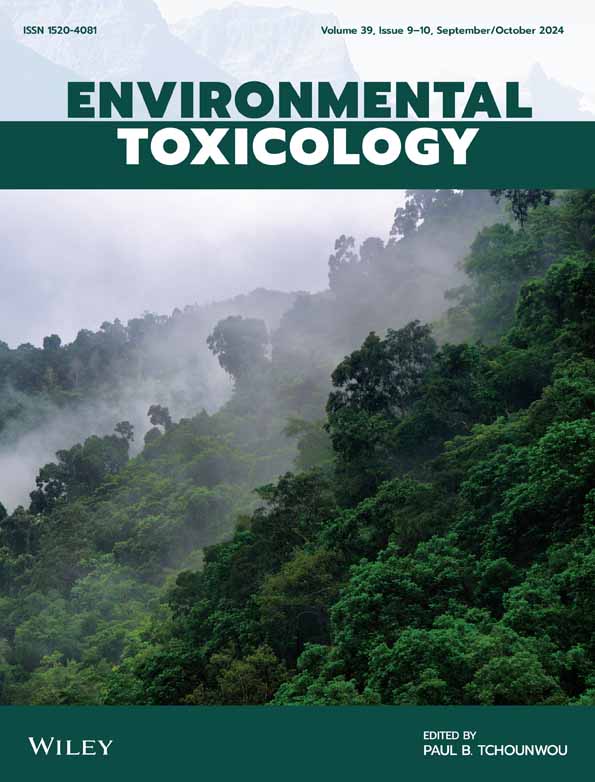From Association to Mechanism: Excessive Exposure to Tin During Pregnancy May Cause Fetal Neural Tube Defects
IF 3.2
3区 医学
Q2 ENVIRONMENTAL SCIENCES
引用次数: 0
Abstract
Despite widespread human exposure to tin, its health effects remain poorly understood. This study examined the role of tin in neural tube defects (NTDs) through a case–control study and animal experiments. Tin levels in maternal serum and placentas were analyzed in 200 NTD cases and 400 controls to explore potential associations. Elevated tin concentrations in maternal serum were associated with an increased risk of NTDs, with an odds ratio of 2.31 (95% CI, 1.13–4.75), with similar associations found for placental tin and tributyltin (TBT) exposure. In animal experiments, pregnant mice exposed to 10–40 mg/kg TBT exhibited a 25.5%–27.6% incidence of fetal NTDs. Maternal TBT exposure increased oxidative stress and apoptosis in embryonic neural tissues. Antibody microarray analysis prioritized MAPK signaling as the dominant perturbed pathway. Subsequent western blot and RT‐qPCR analysis convergently validated TBT‐induced MAPK hyperactivation. Vitamin E supplementation had antagonistic effects, reducing these harmful outcomes. These findings suggest that prenatal tin exposure is a significant risk factor for NTDs. The teratogenic effect of TBT appears to be mediated by enhanced oxidative stress, activation of MAPK signaling, and apoptosis in the developing neural tube, processes that can be mitigated by Vitamin E supplementation. Thus, tin exposure during pregnancy is associated with an increased risk of fetal NTDs, and animal models demonstrate that TBT can induce these defects through specific biological pathways. This research highlights the need for further investigation into tin exposure and its potential health impacts on fetal development.从关联到机制:孕期过量接触锡可能导致胎儿神经管缺陷
尽管人类广泛接触锡,但其对健康的影响仍知之甚少。本文通过病例对照研究和动物实验,探讨了锡在神经管缺损(NTDs)中的作用。分析了200例NTD病例和400例对照者的血清和胎盘中锡的水平,以探讨潜在的关联。母体血清锡浓度升高与NTDs风险增加相关,比值比为2.31 (95% CI, 1.13-4.75),胎盘锡和三丁基锡(TBT)暴露也存在类似关联。在动物实验中,暴露于10-40 mg/kg TBT的妊娠小鼠胎儿ntd发生率为25.5%-27.6%。母体TBT暴露增加胚胎神经组织氧化应激和细胞凋亡。抗体微阵列分析优先考虑MAPK信号作为主要的干扰途径。随后的western blot和RT - qPCR分析均证实了TBT诱导的MAPK过度激活。补充维生素E具有拮抗作用,减少了这些有害的结果。这些发现表明,产前锡暴露是被忽视热带病的重要危险因素。TBT的致畸作用似乎是通过增强氧化应激、激活MAPK信号和发育中的神经管细胞凋亡介导的,这些过程可以通过补充维生素E来缓解。因此,怀孕期间锡暴露与胎儿ntd的风险增加有关,动物模型表明,TBT可以通过特定的生物学途径诱导这些缺陷。这项研究强调需要进一步调查锡暴露及其对胎儿发育的潜在健康影响。
本文章由计算机程序翻译,如有差异,请以英文原文为准。
求助全文
约1分钟内获得全文
求助全文
来源期刊

Environmental Toxicology
环境科学-毒理学
CiteScore
7.10
自引率
8.90%
发文量
261
审稿时长
4.5 months
期刊介绍:
The journal publishes in the areas of toxicity and toxicology of environmental pollutants in air, dust, sediment, soil and water, and natural toxins in the environment.Of particular interest are:
Toxic or biologically disruptive impacts of anthropogenic chemicals such as pharmaceuticals, industrial organics, agricultural chemicals, and by-products such as chlorinated compounds from water disinfection and waste incineration;
Natural toxins and their impacts;
Biotransformation and metabolism of toxigenic compounds, food chains for toxin accumulation or biodegradation;
Assays of toxicity, endocrine disruption, mutagenicity, carcinogenicity, ecosystem impact and health hazard;
Environmental and public health risk assessment, environmental guidelines, environmental policy for toxicants.
 求助内容:
求助内容: 应助结果提醒方式:
应助结果提醒方式:


